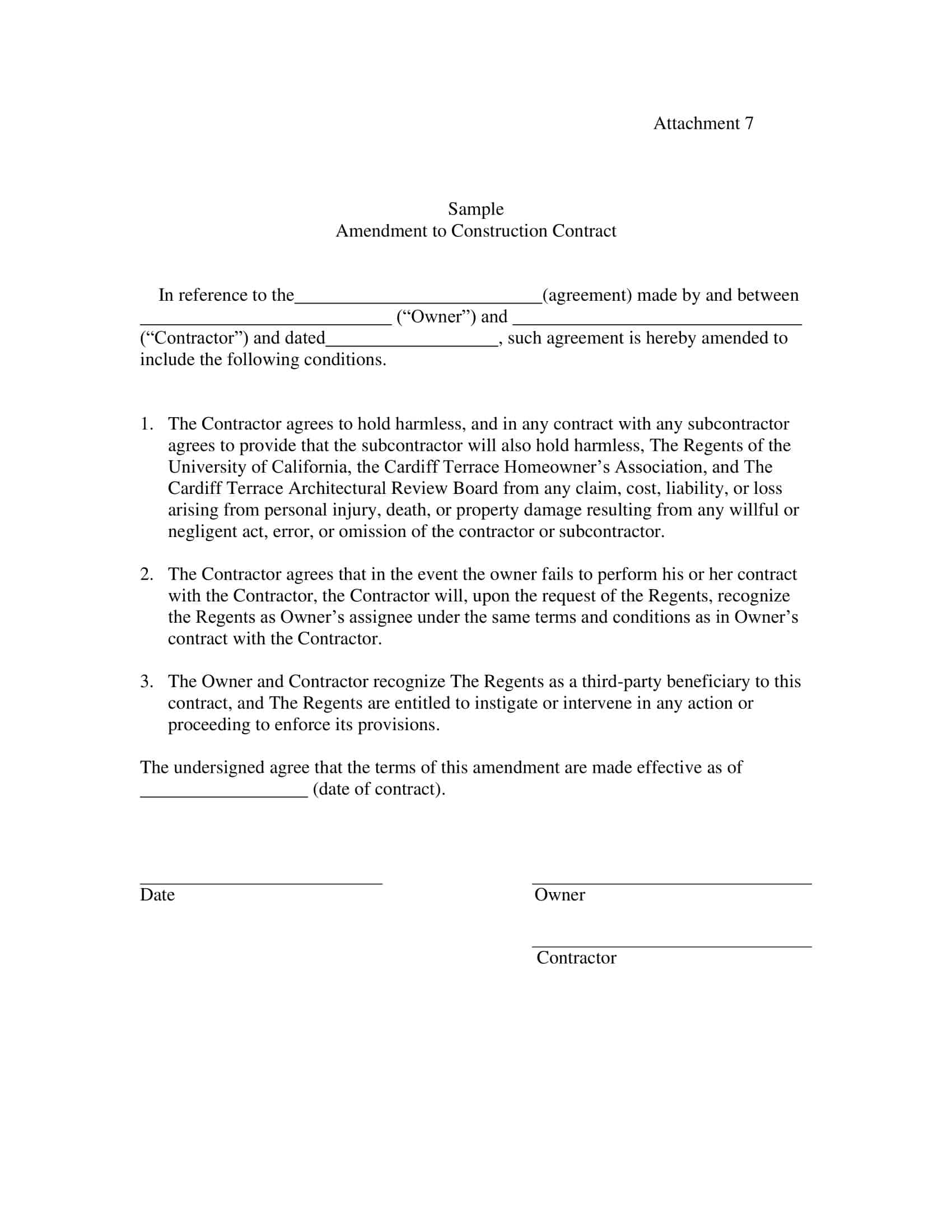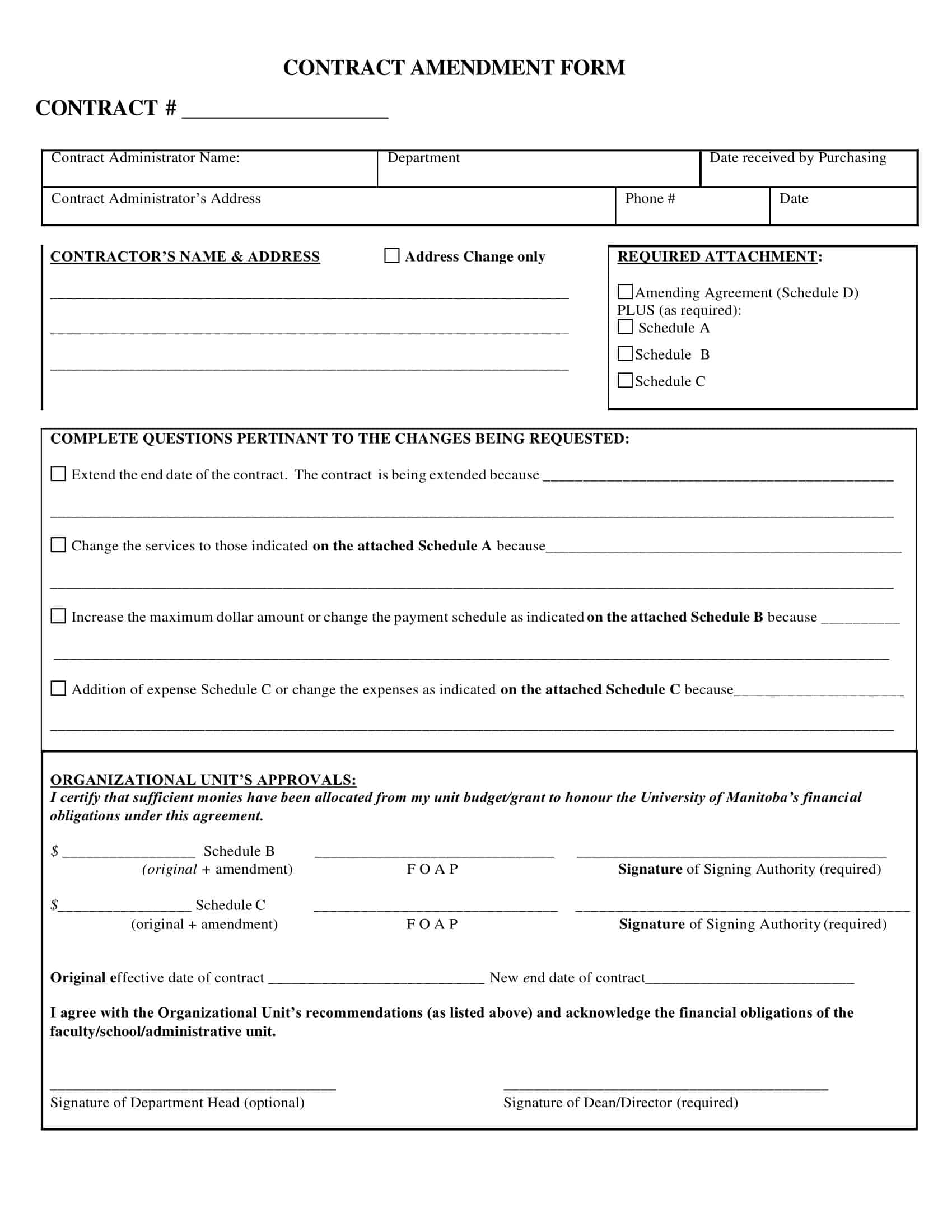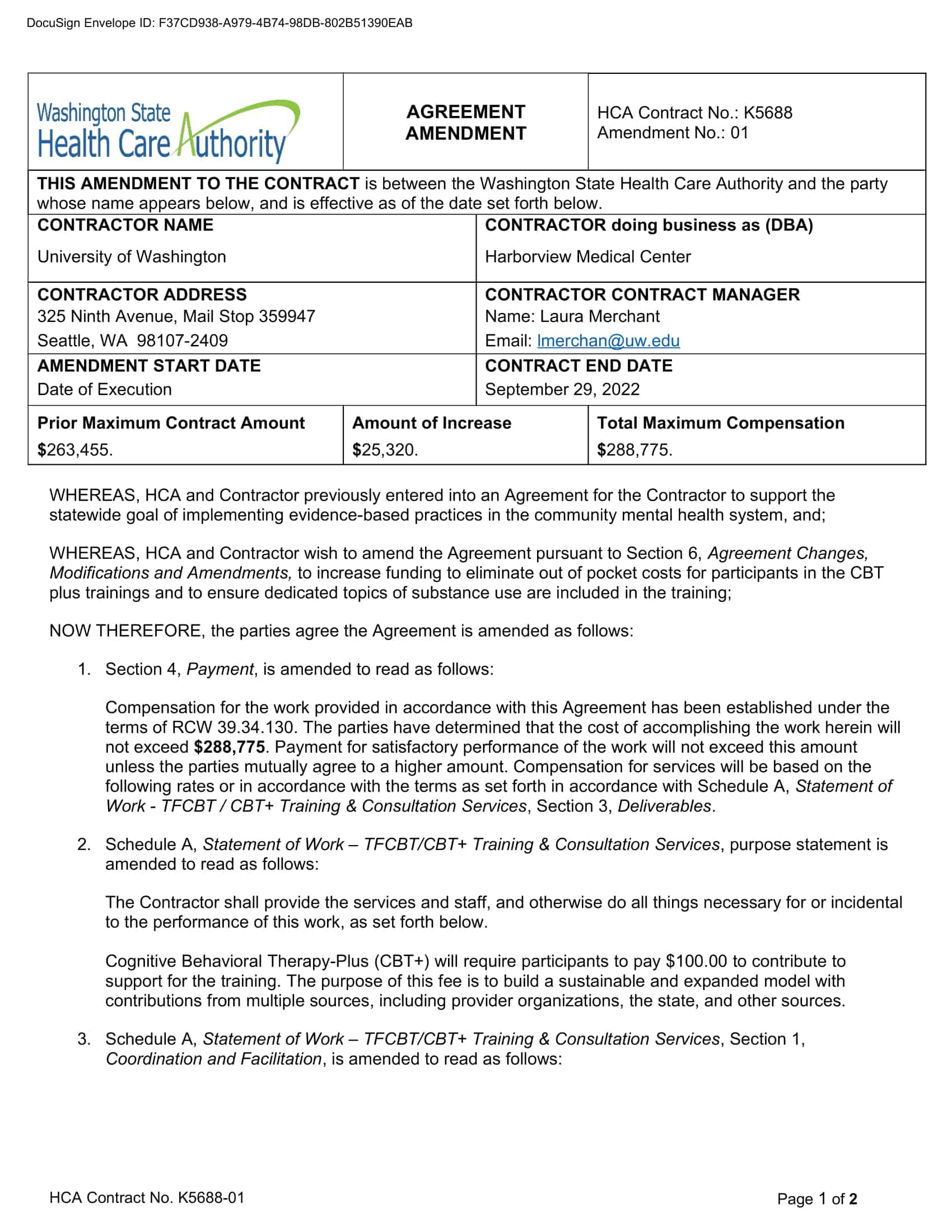A contract amendment is a document that modifies or changes the terms of an existing contract. Contract amendments are often used to make small adjustments to an existing agreement, or to reflect changes in circumstances or circumstances that were not anticipated at the time the original contract was signed.
When a contract is amended, both parties must agree to the changes and the amendment must be signed and dated by both parties. It is important to carefully review and understand the terms of a contract amendment before signing it, as it will become part of the legally binding agreement between the parties. In this article, we will discuss the process of creating and implementing a contract amendment, as well as the considerations that should be taken into account when making changes to an existing contract.
Table of Contents
Contract Amendment Templates
A Contract Amendment is a legal document used to modify or make changes to an existing contract between two or more parties. It serves as an official record of the agreed-upon modifications to the original contract and ensures that all parties are aware of and comply with the revised terms and conditions. The Contract Amendment Template provides a structured format for creating this document.
It is important to note that the specific requirements and format of a Contract Amendment may vary depending on the jurisdiction, the nature of the original contract, and the specific changes being made. It is recommended to consult with legal professionals or seek appropriate legal advice to ensure compliance with applicable laws and regulations.
Contract Amendment Templates can be customized using word processing software or online templates. They provide a standardized and legally recognized document to modify an existing contract and reflect the agreed-upon changes. By using a Contract Amendment Template, all parties involved can have a clear record of the amendments made to the original contract and ensure their rights and obligations are properly documented and understood.
Important things to keep in mind when making a contract amendment

Here are some things to keep in mind when making a contract amendment:
Make sure the amendment is necessary: Only make a contract amendment if it is truly necessary to do so. Consider whether the change can be made through a simple clarification or agreement between the parties, rather than through a formal amendment process.
Review the original contract: Carefully review the original contract to ensure that the proposed amendment does not conflict with any of its provisions.
Get the other party’s agreement: The other party must agree to the amendment in order for it to be legally binding. Make sure to obtain their written consent before proceeding.
Use clear and concise language: Use clear and concise language when drafting the amendment to avoid any confusion or misunderstandings.
Have the amendment reviewed by an attorney: It is a good idea to have the amendment reviewed by an attorney to ensure that it is legally enforceable and protects the interests of both parties.
Keep a copy of the amended contract: Make sure to keep a copy of the amended contract for your records.
Specify the effective date of the amendment: Make sure to specify the effective date of the amendment, as it may not take effect immediately.
Include a clause stating that the amendment supersedes any conflicting provisions: It is a good idea to include a clause stating that the amendment supersedes any conflicting provisions in the original contract. This helps to avoid any confusion or misunderstandings about which provisions take precedence.
Be specific about the changes being made: Clearly specify the changes being made by the amendment. This will help to avoid any confusion or misunderstandings about the nature of the changes.
Consider the long-term implications of the amendment: Think about the long-term implications of the amendment and whether it is in the best interests of both parties.
By following these guidelines and considering all of the relevant factors, you can create a clear and effective contract amendment that reflects the mutual agreements and interests of all parties involved.
What are the methods for creating a contract amendment ?
There are several methods for creating a contract amendment:
Use a contract amendment form: Many businesses and organizations have pre-printed contract amendment forms that can be used to make changes to an existing contract. These forms usually have spaces for the parties to fill in the specific details of the amendment, as well as a place for the parties to sign and date the amendment.
Write a letter of amendment: Another option is to write a letter of amendment that outlines the changes being made to the contract. The letter should be signed and dated by both parties, and a copy should be kept with the original contract.
Make the changes directly to the original contract: In some cases, it may be possible to make the changes directly to the original contract by crossing out or adding language as needed. Any changes should be initialed and dated by both parties.
Use a separate document to record the amendment: A separate document can be used to record the amendment to the original contract. This document should be signed and dated by both parties, and a copy should be kept with the original contract.
Consult with an attorney: It is a good idea to consult with an attorney when creating a contract amendment, especially if the changes are significant or complex. An attorney can help ensure that the amendment is legally enforceable and protects the interests of both parties.
Use clear and concise language: Use clear and concise language when drafting the amendment to avoid any confusion or misunderstandings.
Specify the effective date of the amendment: Make sure to specify the effective date of the amendment, as it may not take effect immediately.
Include a clause stating that the amendment supersedes any conflicting provisions: It is a good idea to include a clause stating that the amendment supersedes any conflicting provisions in the original contract. This helps to avoid any confusion or misunderstandings about which provisions take precedence.
Be specific about the changes being made: Clearly specify the changes being made by the amendment. This will help to avoid any confusion or misunderstandings about the nature of the changes.
Regardless of the method used, it is important to ensure that the amendment is clearly documented and that both parties agree to the changes. This will help to avoid any confusion or misunderstandings about the terms of the amended contract.
Addendum vs. Amendment: What’s the Difference?
An addendum is a document that is added to an existing contract to provide additional information or clarification. An amendment is a document that modifies or changes the terms of an existing contract.
One key difference between an addendum and an amendment is that an addendum is used to provide additional information or clarification, while an amendment is used to make changes to the terms of the contract. An addendum is typically used to address issues or circumstances that were not anticipated at the time the original contract was signed, while an amendment is used to make changes to the existing terms of the contract.
Another difference is that an addendum is typically less formal than an amendment. An addendum is usually a separate document that is attached to the original contract, while an amendment is usually incorporated directly into the original contract.
In general, it is important to carefully review and understand any addendums or amendments to a contract before signing them, as they will become part of the legally binding agreement between the parties.
Six Tips for Writing Contract Amendments
Here are some tips for creating a contract amendment:
Make sure the amendment is necessary: Only make a contract amendment if it is truly necessary to do so. Consider whether the change can be made through a simple clarification or agreement between the parties, rather than through a formal amendment process.
Review the original contract: Carefully review the original contract to ensure that the proposed amendment does not conflict with any of its provisions.
Get the other party’s agreement: The other party must agree to the amendment in order for it to be legally binding. Make sure to obtain their written consent before proceeding.
Use clear and concise language: Use clear and concise language when drafting the amendment to avoid any confusion or misunderstandings.
Have the amendment reviewed by an attorney: It is a good idea to have the amendment reviewed by an attorney to ensure that it is legally enforceable and protects the interests of both parties.
Keep a copy of the amended contract: Make sure to keep a copy of the amended contract for your records.
Conclusion
In conclusion, a contract amendment is a valuable tool for making changes to an existing contract. By carefully reviewing the original contract, using clear and concise language, and obtaining the agreement of all parties involved, you can create a legally binding amendment that reflects the mutual agreements and interests of all parties.
It is important to consult with an attorney to ensure that the amendment is enforceable and protects the interests of all parties, and to keep a copy of the amended contract for your records. By following these guidelines and considering all of the relevant factors, you can effectively and efficiently modify an existing contract to meet the changing needs and circumstances of the parties involved.
FAQs
What is the difference between an amendment and an addendum?
An amendment formally alters or adds new terms to existing contract language, while an addendum appends additional information without directly changing original wording. Amendments can modify agreements; addendums supplement them.
How do you write an addendum to a contract?
When writing a contract addendum: Identify original contracting parties, restate agreement name/date, title addendum using “Attachment A/B” format, directly specify intended additions/clarifications referring to original sections if applicable, state “All other terms remain unchanged”, add signature and date lines.
Can a written contract be amended?
Yes, a written contract can be amended with mutual consent if the agreement includes an “Amendments Clause” or using a separate amendment document. Key aspects like parties involved, consideration, object of agreement must remain for enforceability. Updates should align to original purpose or scope.
What is an amendment to a contract called?
A formal change made to a signed contract is referred to as a contract amendment. Typical formats used are titled “Amendment No. 1 To [Agreement Name]” or “Amendment Agreement to [Original Contract Name]”. Signatures from authorized parties are required.
What is an amendment clause in a contract?
An amendment clause (or “changes clause”) in a contract permits existing terms and conditions to be modified if mutually agreed on by all parties signing the original agreement through formal amendment documents. These help alter aspects needing updates after initial execution.
How do you write a contract modification?
To write a contract modification:
- Name original agreement and parties
- Specify “Modification #1”
- Note original term changing
- State reason for change
- Specify new term with context
- Indicate remaining terms intact
- Add signature/date lines





















































![%100 Free Hoodie Templates [Printable] +PDF 1 Hoodie Template](https://www.typecalendar.com/wp-content/uploads/2023/05/Hoodie-Template-1-150x150.jpg)
![Free Printable Catering Contract Templates [Word, PDF] Simple 2 Catering Contract](https://www.typecalendar.com/wp-content/uploads/2023/05/Catering-Contract-1-150x150.jpg)
![Free Printable Land Contract Templates [Word, PDF] Simple 3 Land Contract](https://www.typecalendar.com/wp-content/uploads/2023/05/Land-Contract-1-150x150.jpg)
